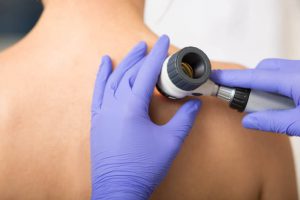Outdoor worker sun damage
Every day in Australia, 22% of our workforce is exposed to solar UV radiation and it’s these outdoor workers are at an increased risk of developing keratinocyte cancers. Keratinocyte cancers are non-melanoma skin cancers, and represent the most common cancers in Australia.
Data collected by Safe Work Australia between the years 2010 to 2018 shows that during this period, 1,208 workers compensation claims for skin cancer were accepted at a total cost of $32.8 million.5

BCC and SCC
There are two main types of keratinocyte skin cancers:
- basal cell carcinoma (BCC)
- squamous cell carcinoma (SCC)
BCC accounts for about 70% of non-melanoma skin cancers.
It’s the energy from the sun that is transmitted as solar radiation which is the major cause of keratinocyte cancers, such as Basal Cell Carcinoma (BCC) and Squamous Cell Carcinoma (SCC). It is possible to reduce the risk of keratinocyte cancers through avoidance of excessive sun exposure starting from childhood.2
Through regular exposure to the sun, it is known that the occurrence of basal cell carcinoma is more common at an earlier age than squamous cell carcinomas.2
A relatively common location for the occurrence of BCC to be found is on the neck, back, shoulders and trunk with highest incidence on the face – this includes all high sun exposed areas such as eyelid, nose, cheeks and ears. BCC is the most common form of skin cancer in Australia and they require a lower threshold of total solar radiation to develop into a malignant transformation.1
Workplace skin checks – WA
It’s not uncommon to see Aussie outdoor workers with actinic damage. During our onsite workplace skin screening programs, we regularly see sun damaged skin. This is more commonly on light skinned individuals who spend a lot of time outside. We probably all know someone who has lots of freckles and sunspots. These are known as ephelides, solar lentigo, and actinic keratosis. Not all sunspots turn into skin cancer, the chances that an individual actinic keratosis will develop into an SCC are extremely small; however, when we find an SCC, the chance that it has arisen in association with actinic keratosis is very high.2
In reality if you’re an outdoor worker it’s not always easy to avoid the sun, but being sun smart should be part of your everyday routine. Wear protective clothing, apply sunscreen to exposed areas of skin (don’t forget your ears and lips), wear a broad brimmed hat, seek shade whenever possible and make sure you wear your sunnies.4
Dont forget to protect your lips!
Your face has several high impact zones that are affected by the sun and the bottom lip is one area that may be affected by Actinic Cheilitis (AC) and SCC. Remember to take care of your lips, and watch out for any of the clinical signs of AC of the lower lip which include; blurring of the lip line, dryness, with red and milky white areas, crusting, and ulceration.4
If you are an outdoor worker don’t forget to apply sunscreen to your lips. Our lips get a lot of exposure to the sun, especially if your bottom lip protrudes slightly. Actinic Cheilitis (AC) is considered to be a potentially malignant change related to chronic sun exposure and light skinned males are affected more frequently and there is a strong association with smoking and outdoor occupations.3
- Australian Cancer Network. (2008). Clinical practice guide: Basal cell carcinoma, squamous cell carcinoma (and related lesions): a guide to clinical management in Australia
- Clinical practice guidelines for keratinocyte cancer. (2019)
- Kolokythas, A. (2014). Lip cancer.
- Rigel, D. S., Friedman, R., Robinson, J. K., Ross, M. I., Cockerell, C. J., Lim, H., Stockfleth, E., & Kirkwood, J. M. (2011). Cancer of the skin (2nd ed.). Elsevier Health Sciences.
- Workplace Skin Cancer Statistics & Issues (2022).
